Clouds Cast Thousand-mile Shadows Into Space When Viewed Aboard The International Space Station
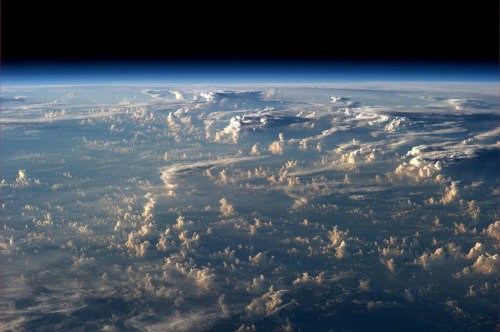
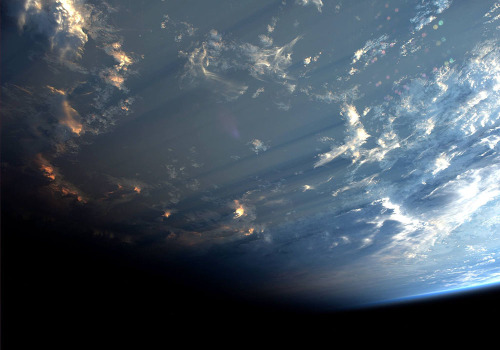
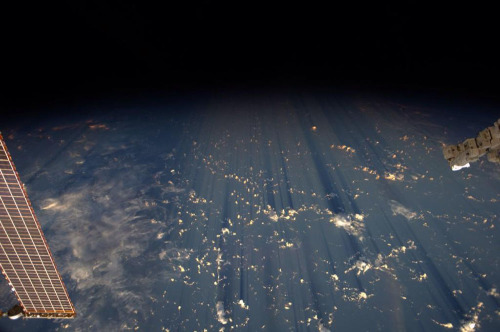
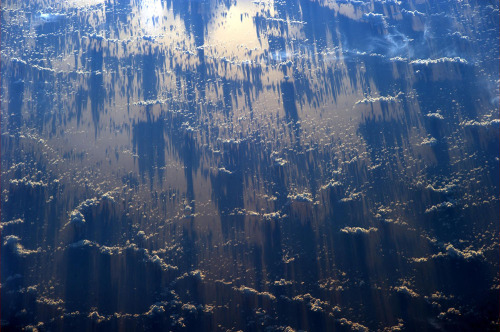
Clouds cast thousand-mile shadows into space when viewed aboard the International Space Station
More Posts from Night-hides-the-world and Others
Everyone (Even You!) Can Use Satellite Data
At NASA we’re pretty great at putting satellites and science instruments into orbit around Earth. But it turns out we’re also pretty great at showing people how to get and use all that data.
One of the top ways you can learn how to use NASA data is our ARSET program. ARSET is our Applied Remote Sensing Training program and it helps people build skills that integrate all these Earth science data into their decision making.

ARSET will train you on how to use data from a variety of Earth-observing satellites and instruments aboard the International Space Station.
Once you take a training, you’ll be in GREAT company because thousands of people have taken an ARSET training.

We hold in person and online trainings to people around the world, showing them how to use NASA Earth science data. Trainings are offered in air quality, climate, disaster, health, land, water resources and wildfire management.
For example, if you’re trying to track how much fresh drinking water there is in your watershed, you can take an ARSET training and learn how to find satellite data on how much precipitation has fallen over a certain time period or even things like the ‘moistness’ of soil and the quality of the water.

Best yet, all NASA Earth observing data is open and freely available to the whole world! That’s likely one of the reasons we’ve had participants from 172 of the approximately 190 countries on Earth.

Since its beginning 10 years ago, ARSET has trained more than 30 thousand people all over the world. They’ve also worked with people from more than 7,500 different organizations and that includes government agencies, non-profit groups, advocacy organizations, private industry.
And even though 2019 is ARSET’s 10th birthday – we’ve only just begun. Every year about 60% of the organizations and agencies we train are new to the program. We’re training just about anyone who is anyone doing Earth science on Earth!
Join us, learn more about how we train people to use Earth observing data here, and heck, you can even take a training yourself: https://arset.gsfc.nasa.gov/.
Make sure to follow us on Tumblr for your regular dose of space: http://nasa.tumblr.com

What do you get when you combine a doctor, engineer & astronaut? Mae Carol Jemison! Dr. Jemison flew on Space Shuttle Endeavour in Sept 1992 to become the 1st African-American woman in space. The 7-day, 22-hour flight was the 50th Shuttle mission & had a focus on conducting microgravity investigations in materials & life sciences. Dr. Jemison also holds an amazing 9 doctorates; don’t know how that’s humanly possible; getting my BA was tough enough!
Solar System 10 Things: Looking Back at Pluto
In July 2015, we saw Pluto up close for the first time and—after three years of intense study—the surprises keep coming. “It’s clear,” says Jeffery Moore, New Horizons’ geology team lead, “Pluto is one of the most amazing and complex objects in our solar system.”
1. An Improving View

These are combined observations of Pluto over the course of several decades. The first frame is a digital zoom-in on Pluto as it appeared upon its discovery by Clyde Tombaugh in 1930. More frames show of Pluto as seen by the Hubble Space Telescope. The final sequence zooms in to a close-up frame of Pluto taken by our New Horizons spacecraft on July 14, 2015.
2. The Heart

Pluto’s surface sports a remarkable range of subtle colors are enhanced in this view to a rainbow of pale blues, yellows, oranges, and deep reds. Many landforms have their own distinct colors, telling a complex geological and climatological story that scientists have only just begun to decode. The image resolves details and colors on scales as small as 0.8 miles (1.3 kilometers). Zoom in on the full resolution image on a larger screen to fully appreciate the complexity of Pluto’s surface features.
3. The Smiles

July 14, 2015: New Horizons team members Cristina Dalle Ore, Alissa Earle and Rick Binzel react to seeing the spacecraft’s last and sharpest image of Pluto before closest approach.
4. Majestic Mountains

Just 15 minutes after its closest approach to Pluto, the New Horizons spacecraft captured this near-sunset view of the rugged, icy mountains and flat ice plains extending to Pluto’s horizon. The backlighting highlights more than a dozen layers of haze in Pluto’s tenuous atmosphere. The image was taken from a distance of 11,000 miles (18,000 kilometers) to Pluto; the scene is 780 miles (1,250 kilometers) wide.
5. Icy Dunes

Found near the mountains that encircle Pluto’s Sputnik Planitia plain, newly discovered ridges appear to have formed out of particles of methane ice as small as grains of sand, arranged into dunes by wind from the nearby mountains.
6. Glacial Plains

The vast nitrogen ice plains of Pluto’s Sputnik Planitia – the western half of Pluto’s “heart”—continue to give up secrets. Scientists processed images of Sputnik Planitia to bring out intricate, never-before-seen patterns in the surface textures of these glacial plains.
7. Colorful and Violent Charon

High resolution images of Pluto’s largest moon, Charon, show a surprisingly complex and violent history. Scientists expected Charon to be a monotonous, crater-battered world; instead, they found a landscape covered with mountains, canyons, landslides, surface-color variations and more.
8. Ice Volcanoes

One of two potential cryovolcanoes spotted on the surface of Pluto by the New Horizons spacecraft. This feature, known as Wright Mons, was informally named by the New Horizons team in honor of the Wright brothers. At about 90 miles (150 kilometers) across and 2.5 miles (4 kilometers) high, this feature is enormous. If it is in fact an ice volcano, as suspected, it would be the largest such feature discovered in the outer solar system.
9. Blue Rays

Pluto’s receding crescent as seen by New Horizons at a distance of 120,000 miles (200,000 kilometers). Scientists believe the spectacular blue haze is a photochemical smog resulting from the action of sunlight on methane and other molecules in Pluto’s atmosphere. These hydrocarbons accumulate into small haze particles, which scatter blue sunlight—the same process that can make haze appear bluish on Earth.
10. Encore

On Jan. 1, 2019, New Horizons will fly past a small Kuiper Belt Object named MU69 (nicknamed Ultima Thule)—a billion miles (1.5 billion kilometers) beyond Pluto and more than four billion miles (6.5 billion kilometers) from Earth. It will be the most distant encounter of an object in history—so far—and the second time New Horizons has revealed never-before-seen landscapes.
Make sure to follow us on Tumblr for your regular dose of space: http://nasa.tumblr.com.
COMPARISON PHOTOS: hubble vs james webb
SMACS 0723
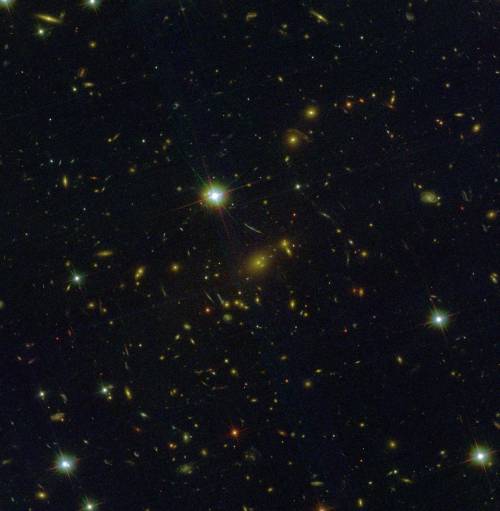
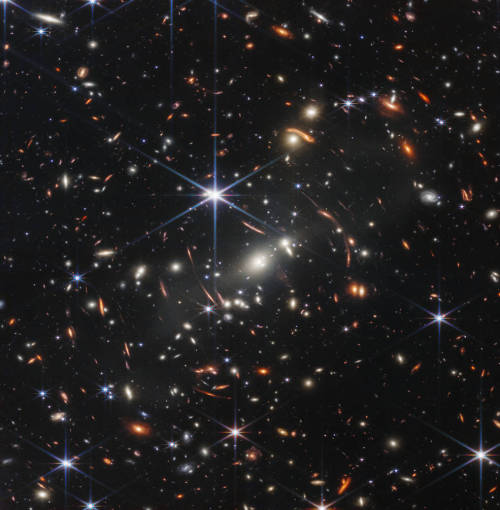
southern ring nebula

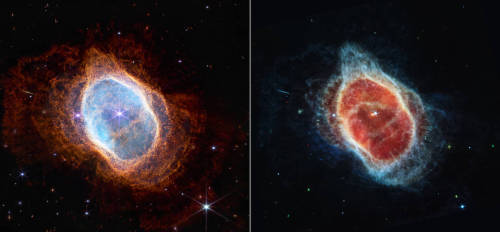
carina nebula (NGC 3324)
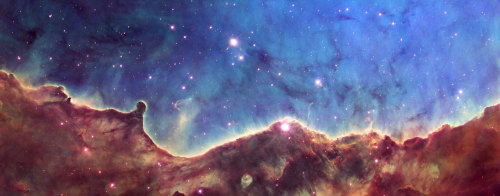
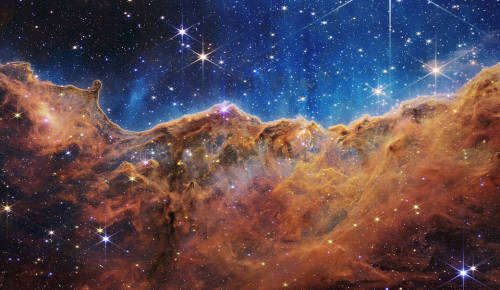
stephan's quintet


Source is Discovery Chanel. Here’s a video.

The largest known star in the universe, compared to Earth.
In order of appearance - Earth, Sol (Our Sun), Sirius, Betelgeuse, Canis Majoris.
Canis Majoris is in fact so large, that if it were to replace our own sun the star itself would extend outwards past the orbit of Jupiter.
[Click for more interesting science facts and gifs]
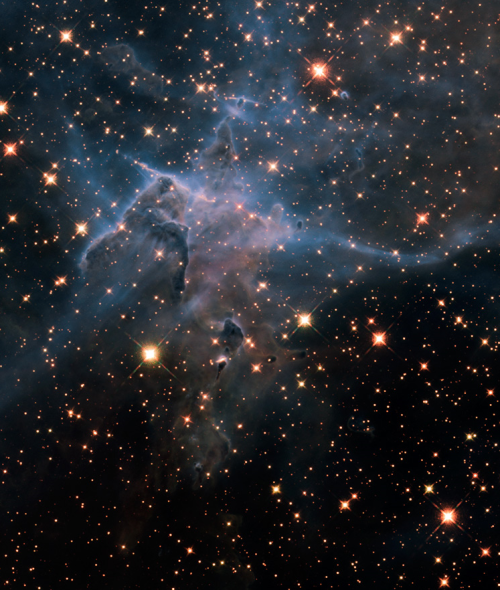
The Mystic Mountain - HH 901
This is a NASA Hubble Space Telescope near-infrared-light image of a three-light-year-tall pillar of gas and dust that is being eaten away by the brilliant light from nearby stars in the tempestuous stellar nursery called the Carina Nebula, located 7,500 light-years away in the southern constellation Carina. The image marks the 20th anniversary of Hubble’s launch and deployment into an orbit around Earth.
The image reveals a plethora of stars behind the gaseous veil of the nebula’s wall of hydrogen, laced with dust. The foreground pillar becomes semi-transparent because infrared light from background stars penetrates through much of the dust. A few stars inside the pillar also become visible. The false colors are assigned to three different infrared wavelength ranges.
Credit: NASA, ESA
Gobble Up These Black (Hole) Friday Deals!
Welcome to our 6th annual annual Black Hole Friday! Check out these black hole deals from the past year as you prepare to head out for a shopping spree or hunker down at home to avoid the crowds.
First things first, black holes have one basic rule: They are so incredibly dense that to escape their surface you’d have to travel faster than light. But light speed is the cosmic speed limit … so nothing can escape a black hole’s surface!
Black hole birth announcements
Some black holes form when a very large star dies in a supernova explosion and collapses into a superdense object. This is even more jam-packed than the crowds at your local mall — imagine an object 10 times more massive than the Sun squeezed into a sphere with the diameter of New York City!

Some of these collapsing stars also signal their destruction with a huge burst of gamma rays. Our Fermi Gamma-ray Space Telescope and Neil Gehrels Swift Observatory continuously seek out the signals of these gamma ray bursts — black hole birth announcements that come to us from across the universe.
NICER black holes
There are loads of stellar mass black holes, which are just a few 10s of times the Sun’s mass, in our home galaxy alone — maybe even hundreds of millions of them! Our Neutron Star Interior Composition Explorer, or NICER for short, experiment on the International Space Station has been studying some of those relatively nearby black holes.

Near one black hole called GRS 1915+105, NICER found disk winds — fast streams of gas created by heat or pressure. Scientists are still figuring out some puzzles about these types of wind. Where do they come from, for example? And do they change the way material falls into the black hole? Every new example of these disk winds helps astronomers get closer to answering those questions.
Merging monster black holes
But stellar mass black holes aren’t the only ones out there. At the center of nearly every large galaxy lies a supermassive black hole — one with the mass of millions or billions of Suns smooshed into a region no bigger than our solar system.

There’s still some debate about how these monsters form, but astronomers agree that they certainly can collide and combine when their host galaxies collide and combine. Those black holes will have a lot of gas and dust around them. As that material is pulled into the black hole it will heat up due to friction and other forces, causing it to emit light. A group of scientists wondered what light it would produce and created this mesmerizing visualization showing that most of the light produced around these two black holes is UV or X-ray light. We can’t see those wavelengths with our own eyes, but many telescopes can. Models like this could help scientists know what to look for to spot a merger.
Black holes power bright gamma ray lights
It also turns out that these supermassive black holes are the source of some of the brightest objects in the gamma ray sky! In a type of galaxy called active galactic nuclei (also called “AGN” for short) the central black hole is surrounded by a disk of gas and dust that’s constantly falling into the black hole.

But not only that, some of those AGN have jets of energetic particles that are shooting out from near the black hole at nearly the speed of light! Scientists are studying these jets to try to understand how black holes — which pull everything in with their huge amounts of gravity — provide the energy needed to propel the particles in these jets. If that jet is pointed directly at us, it can appear super-bright in gamma rays and we call it a blazar. These blazars make up more than half of the sources our Fermi space telescope sees.
Catching particles from near a black hole
Sometimes scientists get a two-for-one kind of deal when they’re looking for black holes. Our colleagues at the IceCube Neutrino Observatory actually caught a particle from a blazar 4 billion light-years away. IceCube lies a mile under the ice in Antarctica and uses the ice itself to detect neutrinos, tiny speedy particles that weigh almost nothing and rarely interact with anything. When IceCube caught a super-high-energy neutrino and traced its origin to a specific area of the sky, they turned to the astronomical community to pinpoint the source.

Our Fermi spacecraft scans the entire sky about every three hours and for months it had observed a blazar producing more gamma rays than usual. Flaring is a common characteristic in blazars, so this didn’t attract special attention. But when the alert from IceCube came through, scientists realized the neutrino and the gamma rays came from the same patch of sky! This method of using two or more kinds of signals to learn about one event or object is called multimessenger astronomy, and it’s helping us learn a lot about the universe.

Get more fun facts and information about black holes HERE and follow us on social media today for other cool facts and findings about black holes!
Make sure to follow us on Tumblr for your regular dose of space: http://nasa.tumblr.com.

Thousands of Stars in the Orion Nebula
Close inspection of the 2006 Hubble Space Telescope color mosaic of the Orion Nebula (M42) reveals numerous treasures that reside within the nearby, intense star- forming region. Southwest of the Trapezium stars located in the center of the nebula, a stunning Hubble Heritage portrait captures a variety of intricate objects. Deeply contrasting areas of light and dark blend with a palette of colors mix to form rich swirls and fluid motions that would make even the best artists stand back and admire their work.
Visible slightly bottom right center is the star LL Orionis (LL Ori), originally release by the Hubble Heritage Project in 2002. The delicate bow shock that surrounds LL Ori points towards the stream of gas flowing slowly away from the center of the Orion Nebula, near the Trapezium stars located off the image to the upper left. Close examination of the ends of the bow shock show secondary shocks that are formed as a two-sided jet of gas flowing away from this forming star at high velocity strikes the stream of low velocity gas from the center. To the right of LL Ori, a ghostly veil of material hangs thick and dark, obscuring portions of the nebula behind it.
Credit: NASA/Hubble
-
 sabercrown12 liked this · 3 months ago
sabercrown12 liked this · 3 months ago -
 monkeygines liked this · 7 months ago
monkeygines liked this · 7 months ago -
 harmcityherald reblogged this · 7 months ago
harmcityherald reblogged this · 7 months ago -
 she-is-art-to-me liked this · 7 months ago
she-is-art-to-me liked this · 7 months ago -
 frei-nah reblogged this · 7 months ago
frei-nah reblogged this · 7 months ago -
 frei-nah liked this · 7 months ago
frei-nah liked this · 7 months ago -
 rachedram liked this · 7 months ago
rachedram liked this · 7 months ago -
 wakayume liked this · 8 months ago
wakayume liked this · 8 months ago -
 hira8eth reblogged this · 11 months ago
hira8eth reblogged this · 11 months ago -
 hira8eth liked this · 11 months ago
hira8eth liked this · 11 months ago -
 seaside-sometime reblogged this · 1 year ago
seaside-sometime reblogged this · 1 year ago -
 yodawashere reblogged this · 1 year ago
yodawashere reblogged this · 1 year ago -
 pardon-my-obsessive-tendencies reblogged this · 1 year ago
pardon-my-obsessive-tendencies reblogged this · 1 year ago -
 meu-fascinismo reblogged this · 1 year ago
meu-fascinismo reblogged this · 1 year ago -
 modifiedgoddess reblogged this · 1 year ago
modifiedgoddess reblogged this · 1 year ago -
 open-window-my-soul reblogged this · 1 year ago
open-window-my-soul reblogged this · 1 year ago -
 whippedcreamburrito reblogged this · 1 year ago
whippedcreamburrito reblogged this · 1 year ago -
 kreasecock liked this · 1 year ago
kreasecock liked this · 1 year ago -
 travemetun liked this · 1 year ago
travemetun liked this · 1 year ago -
 cryingsharksfan liked this · 1 year ago
cryingsharksfan liked this · 1 year ago -
 solisandra liked this · 1 year ago
solisandra liked this · 1 year ago -
 iwillhaveamoonbase liked this · 2 years ago
iwillhaveamoonbase liked this · 2 years ago -
 lzloki reblogged this · 2 years ago
lzloki reblogged this · 2 years ago -
 y-love-gothic liked this · 2 years ago
y-love-gothic liked this · 2 years ago -
 xphntmsftx liked this · 2 years ago
xphntmsftx liked this · 2 years ago -
 emmyspov liked this · 2 years ago
emmyspov liked this · 2 years ago -
 heocsy liked this · 2 years ago
heocsy liked this · 2 years ago -
 concupiscience reblogged this · 3 years ago
concupiscience reblogged this · 3 years ago
Astronomy and the other wonders you witness when you look to the skies.
115 posts























